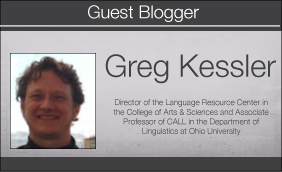Collaborative Language Learning in Participatory Culture
 By Greg Kessler, Director of the Language Resource Center in the College of Arts & Sciences and Associate Professor of CALL in the Department of Linguistics at Ohio University. Past president of the Computer Assisted Language Instruction Consortium (CALICO).
By Greg Kessler, Director of the Language Resource Center in the College of Arts & Sciences and Associate Professor of CALL in the Department of Linguistics at Ohio University. Past president of the Computer Assisted Language Instruction Consortium (CALICO).
DOI: https://www.doi.org/10.69732/IFHI4081
The emergence of participatory co-constructed culture within social media contexts has disrupted nearly all realms of society today. We crowdsource our shopping choices, dining options and political decisions. We engage in varied discourse with a breadth of individuals around both trivial and significant issues. We enhance our understanding of the world through aggregated data mapping and a variety of mash-ups allowing us to make wholly new connections between social, economic, philosophical and other issues. The potential for using these changing communication practices and tools in language learning is vast. However, there is little evidence that such innovation is occurring across language instruction. While the introduction of these participatory practices could significantly alter the landscape of language education, we can learn to adapt them to enhance our current pedagogical practices quite easily. In doing so it is important that we maintain a focus upon the collaborative and participatory potential of all, thus empowering students to engage in learning as they might already engage in social media.
These participatory social media contexts are all focused around the use of language and the increasingly varied ways we are mashing up technology and language. These changes have resulted in an array of linguistic and extra-linguistic digital artifacts. Developing an understanding of these new representations is much like learning a new language. In order to participate within this culture, we need to develop appropriate literacies, including the ability to decode these artifacts. In doing so, we can benefit from an awareness of context, social norms, and other characteristics of any given social media community. Of course, these communities are co-constructed by members, resulting in a constant state of flux that some may refer to as perpetual beta. For example, we are not only continually adjusting our practices to technological changes, but we are also adjusting our language use within this paradigm shift. This reality presents us with a level of uncertainty that is likely to intimidate or overwhelm instructors. However, a little effort to stay informed can go a long way. By discussing the role that these forms of communication play within our lives today with our students and colleagues, we are able to become engaged participants in their design.
This co-construction of knowledge is precisely what constructivist learning is based upon. By creating language learning and practice experiences that mimic the activities within social media or are contextualized within the realm of participatory culture, we are able to provide students with authentic, meaningful and engaging opportunities. The practices associated with this kind of language production are likely to be quite different from typical language classroom practices. They are also likely to be more relevant to the authentic language needs of learners today.
For many years I have focused my work upon CALL teacher preparation so I approach this topic from that perspective. I want to help language teachers recognize how they can integrate these practices in their instruction. For some, this may mean a radical restructuring of the classroom while for others it may simply result in some occasional brief activities. Here are a few examples of activities that may empower students through the promotion of participatory co-construction. An instructor who wants to radically reconfigure a class based on these premises may have students construct their own L2 identities within a collaboratively constructed environment such as Minecraft. This environment requires participants to create every detail of the world they inhabit by mining the materials. It is a wildly popular game and some have incorporated it into instruction. At Ohio University, Jeff Kuhn has built an ESL freshman composition course around this premise. While the students co-construct the world, they engage many of the same interactions, conflicts and negotiations that humans have had for generations as they have built societies. However, in this context the pace is extremely accelerated. In this class students are writing about the experience throughout the process. Needless to say, these compositions are much more earnest and compelling than typical freshman compositions.
More cautious instructors may benefit from experimenting with some more simple practices. For example, beginning language students could construct Internet memes that combine cultural icons and brief text in some significant way. These could be exchanged through a social media context such as Facebook, inviting classmates and others to comment. Another simple example could involve students contributing to Wikipedia entries in the target language. While Wikipedia is filled with many entries in other languages, there are likely to be many local or unique topics that have yet to be addressed. By creating brief introductory entries, students can feel a sense of accomplishment in the L2. Authentic contributions in such contexts also provide opportunities for feedback from a variety of others. There are so many potential experiences that could be designed for any given group of learners that it may be best to involve students in the process. In fact, allowing them to create language learning lessons that they would find authentic and meaningful may motivate some students to participate. Of course, there are numerous other ways that we can embrace these practices in language education. What is important is that we recognize that the co-constructed world of communication is changing rapidly. Not only should we be aware of these changes, we should be active participants guiding that change toward our own needs.

